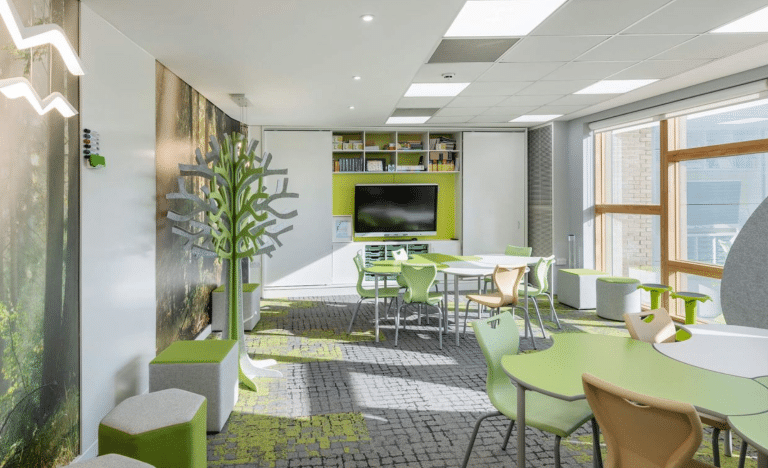How School Furniture Shapes the Learning Experience
Feb 6, 2024 • 5 minutes

The significance of school furniture in impacting learning outcomes is frequently overlooked. The arrangement, flexibility, and ergonomics of the classroom play a pivotal role in shaping students’ experiences and influencing their academic success. In this blog, we will explore the multifaceted aspects of school furniture and its profound effects on various educational activities.
Layout of Classroom Furniture
The way in which desks, chairs, and collaborative areas are organised in a classroom can have a significant impact on the nature of learning activities. For example, circular arrangements can encourage open discussions and group work, creating an inclusive environment. Conversely, rows of desks may be better suited for individual tasks or teacher-led instruction. U-shaped setups promote interaction and engagement during discussions, while clustered tables support teamwork. Workstations with dividers can be useful for assessments or focused individual work.
Flexibility of Learning Spaces
Modern education places a strong emphasis on creating dynamic and adaptable spaces that are conducive to different activities. It prioritises the use of flexible furniture that can be easily adjusted to accommodate various needs, such as group projects or individual study sessions. With adjustable tables and chairs, students and educators have the ability to customise their environment based on the specific requirements of each lesson, fostering engagement and participation.
The flexibility in design allows for quick transformations within the learning space, promoting seamless transitions between different styles of teaching. This adaptability enhances the overall effectiveness of the educational environment by catering to diverse learning preferences and teaching methodologies. The focus on dynamic spaces aims to create a more interactive and personalised educational experience. This modern approach fosters a sense of autonomy and empowerment, encouraging active participation and collaboration among students, while providing educators with greater flexibility in instructional delivery.
Importance of Ergonomics
Ergonomics plays a crucial role in students’ overall physical health and capacity to concentrate on their studies. Chairs and desks need to be carefully crafted to promote correct posture, reducing potential discomfort and minimising distractions.
When students are able to sit comfortably and maintain good posture, they are less likely to experience physical strain or discomfort that could interfere with their focus and attention during classes. The ability to customise furniture according to individual needs can also contribute toward fostering a sense of acceptance and accommodation within the classroom.
Incorporating ergonomic principles into classroom design not only addresses immediate physical concerns but also helps in developing long-term habits related to posture and well-being. It is important for educational institutions to recognise the impact of ergonomics on student learning outcomes and prioritise the creation of supportive environments conducive to optimal academic performance.
Colours and Materials
The selection of colours and materials greatly impacts the emotional and psychological vibe within the teaching space.
Soft, pastel colours are frequently advised for primary schools, as they contribute to creating a peaceful and welcoming environment. This gentle approach has proven to help young children feel at ease and focused while engaging in their studies. The use of light blues, greens, and pinks can promote a sense of tranquillity and aid in reducing distractions.
On the other hand, vibrant and energetic colours are often recommended for high school and secondary school settings. Bright oranges, yellows, and reds can reflect the growing complexity of subjects studied in these institutions. These lively types are believed to foster an invigorating atmosphere that encourages critical thinking and active participation in discussions.
Utilising natural materials like wood can contribute to a warm and inviting setting. Wood evokes a sense of comfort and familiarity, making students feel more at ease in their surroundings. Additionally, the use of these organic materials can connect students with nature and provide a sense of grounding within the classroom.
By selecting the appropriate colour schemes and materials for educational environments, educators can positively impact learning experiences.
Concentration Levels Based on Age
By customising furniture to accommodate age-specific needs, schools can create an environment that nurtures student engagement and academic success. This approach acknowledges the distinct learning styles and preferences of different age groups, fostering an optimal environment for all.
For younger children, furniture that allows for flexibility and movement can facilitate active learning experiences. In contrast, high school students may benefit from adjustable options that support extended periods of concentrated study and individual focus.
Long-term Durability of Classroom Furniture
Investing in durable furniture is a critical aspect of establishing a sustainable learning environment within schools. It involves carefully selecting high-quality materials and construction methods to ensure longevity. By choosing durable options, educational institutions can reduce the frequency of replacements, saving valuable resources and ultimately contributing to cost-effectiveness in the long run.
Durable furniture also helps maintain a consistent and cohesive space, as it stays functional for longer periods without deteriorating. Quality furniture can also contribute to improved safety and comfort for students and staff, enhancing their overall experience in the school environment.
Enhance your learning space with Westcountry Group
The impact of school furniture on the learning experience cannot be overstated. From ergonomic chairs that promote better posture and concentration to flexible seating options that encourage collaboration and creativity, the design of educational furniture plays a crucial role in shaping the way students learn and interact with their environment. By creating comfortable, stimulating, and adaptable spaces, schools can significantly enhance the overall educational experience.
Westcountry Group’s expertise in designing classrooms that promote positive learning outcomes makes us the ideal choice for educational environments.
Contact us today to find out more — call 0330 030 0330 to discuss your project with our educational interior design team, email: sales@westcountrygroup.com or visit https://www.westcountrygroup.com/education.
Let us help you transform your classrooms into spaces that optimise learning and enhance student performance.






